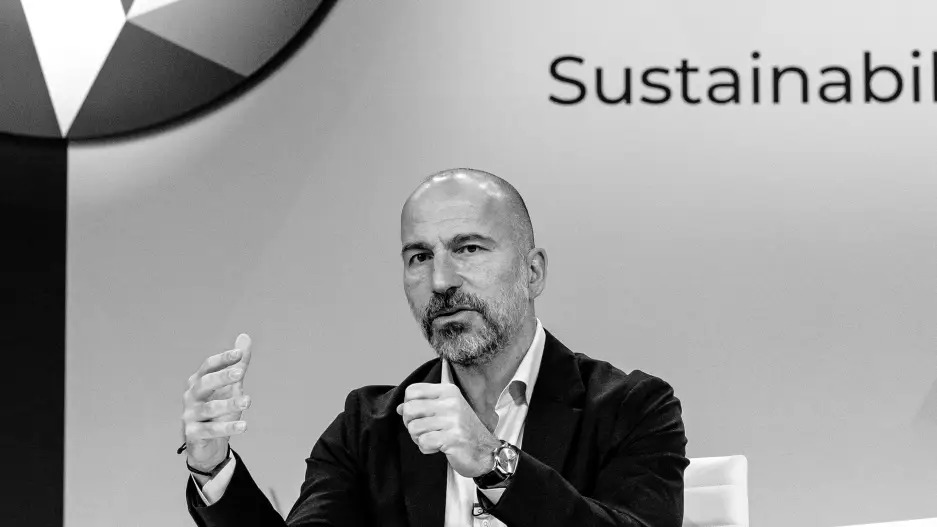- | 8:00 am
Uber CEO Dara Khosrowshahi: We can’t let up on the EV transition
The move to full electrification of ground transport won’t be easy. But now is not the time for industry and government stakeholders to pull back.

As the world’s political and business leaders meet in Davos this week, there’s no shortage of issues to discuss, from the state of the global economy to the Israel-Hamas conflict and the third year of war in Ukraine. With so many pressing matters before us, topics that feel less urgent tend to fall off the agenda. Yet, just weeks out from the hottest year on record, the topic of climate change could not be more critical.
It can feel like there aren’t many reasons for optimism. But ground transport—a large and growing contributor to greenhouse gas emissions—is one of them. In fact, according to the International Energy Agency, the shift to electric vehicles is one of the few bright spots in the energy transition.
Everyone in this industry has a responsibility to help cities reduce the climate impact of urban transportation. At Uber, we also believe that focusing on those who drive for a living—including our drivers—can have outsize climate benefits.
These working drivers drive much more than the average person, so when they go electric, they avoid even more emissions. Such drivers also tend to transport other people, which means more zero-emission mobility with fewer vehicles. And they tend to be overrepresented by low- and middle-income households.
This is reflected in our own data: Uber drivers are going electric seven times faster than the general public. And when one Uber driver starts using an EV, they deliver up to four times the emissions benefits compared to regular motorists.
Even so, the stark reality is that Uber will not reach our zero-emission goals without stronger action from policymakers and businesses. Unfortunately, right at the moment we need to accelerate through the turn, many governments and automakers are slowing down.
Even some of the most ambitious climate leaders are pushing back their commitments to phase out combustion vehicles. Compounded by high interest rates and the inequitable distribution of charging infrastructure, we’re starting to see a slowdown in the appetite for EVs.
This helps explain why automakers are being forced to discount EVs, squeezing margins, reducing investment in more affordable models, and hindering the secondhand EV market.
PROBLEMS TO SOLVE, NOT EXCUSES
Of course, the switch to electric mobility was never going to be easy—but these challenges are problems to solve, not excuses to go slower. I’ve said that climate is a team sport; no one company or government can make progress alone. So in Davos this week, three things should be on our shared agenda.
First, we need more ambitious policies that require automakers to stop selling combustion cars by the next decade. This will bring down the cost of EVs by incentivizing manufacturers to increase production. Few drivers will make the switch unless the total cost of ownership for an EV is at parity with a gas car.
Norway has banned sales of petrol cars by 2025 and today four out of five cars sold are electric. In places like London and California with strong policies, Uber drivers are going electric twice as fast as other Uber drivers in Europe and the U.S., respectively.
Second, governments need to target policies where they will have the most impact. That includes offering incentives for high-mileage and low-income drivers, as well as cultivating the secondhand EV market that will benefit both of these groups.
In the U.K., Manchester has proposed dedicated grants of up to £10,000 for taxi and private hire drivers who want to upgrade to a cleaner car. California offers an EV tax rebate for lower-income households that is more than twice as large as their general rebate. And the U.S. government has a $4,000 tax credit specifically for pre-owned EVs to foster that market.
Cities can help, too, by using public space as an incentive of its own. Today, EV drivers in London avoid the congestion charge, helping to make London Uber’s biggest EV city, with Uber drivers going electric eight times faster than the public. Priority access for EVs in bus lanes and city-center parking in Oslo have supported Norway’s electrification.
Finally, charging infrastructure must be more equitable. Many drivers don’t have driveways or garages, so access to nearby overnight charging is essential. Yet our data shows us that Uber drivers often live in neighborhoods where this infrastructure is most lacking.
These “charging deserts”’ are holding countless people back from making the switch. Amsterdam’s “right to charge” policy has helped address this by giving everyone the ability to get a charger installed on their street. Uber has invested £5m to increase the number of chargers in underserved areas in London and we are sharing our data with city and industry leaders to show them where chargers are most needed. But there’s much more to do.
Looking ahead, all of us—governments, automakers, and businesses—must keep our ambitions high. If we are to hit our collective goals, and avoid the worst impacts of climate change, now is the time to speed up.






































